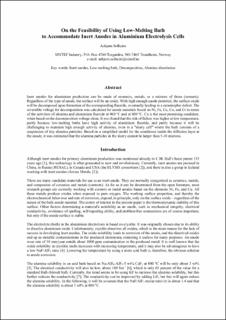| dc.contributor.author | Solheim, Asbjørn | |
| dc.date.accessioned | 2022-09-15T13:42:47Z | |
| dc.date.available | 2022-09-15T13:42:47Z | |
| dc.date.created | 2021-03-22T11:30:55Z | |
| dc.date.issued | 2021 | |
| dc.identifier.citation | Light Metals 2021, pp 511–518 | en_US |
| dc.identifier.issn | 2367-1181 | |
| dc.identifier.uri | https://hdl.handle.net/11250/3018117 | |
| dc.description | Solheim, A. (2021). On the Feasibility of Using Low-Melting Bath to Accommodate Inert Anodes in Aluminium Electrolysis Cells. In: Perander, L. (eds) Light Metals 2021. The Minerals, Metals & Materials Series. Springer, Cham. https://doi.org/10.1007/978-3-030-65396-5_72 | en_US |
| dc.description.abstract | Inert anodes for aluminium production can be made of ceramics, metals, or a mixture of those (cermets). Regardless of the type of anode, the surface will be an oxide. With high enough anode potential, the surface oxide will be decomposed upon formation of the corresponding fluoride, eventually leading to a catastrophic defect. The reversible voltage for decomposition was calculated for anode materials based on Ni, Fe, Cu, Co, and Cr in terms of the activities of alumina and aluminium fluoride at 960 °C and at 800 °C. Cu is the most promising candidate, when based on the decomposition voltage alone. It was found that the risk of failure was higher at low temperature, partly because low-melting baths have high activity of aluminium fluoride, and partly because it will be challenging to maintain high enough activity of alumina, even in a “slurry cell” where the bath consists of a suspension of tiny alumina particles. Based on a simplified model for the conditions inside the diffusion layer at the anode, it was estimated that the alumina particles in the slurry cannot be larger than 5–10 microns. | en_US |
| dc.language.iso | eng | en_US |
| dc.publisher | Springer | en_US |
| dc.rights | Attribution-NonCommercial-NoDerivatives 4.0 Internasjonal | * |
| dc.rights.uri | http://creativecommons.org/licenses/by-nc-nd/4.0/deed.no | * |
| dc.title | On the Feasibility of Using Low-Melting Bath to Accommodate Inert Anodes in Aluminium Electrolysis Cells | en_US |
| dc.type | Peer reviewed | en_US |
| dc.type | Journal article | en_US |
| dc.description.version | acceptedVersion | en_US |
| dc.rights.holder | This is a post-peer-review, pre-copyedit version of an article published in Light Metals 2021, Part of the The Minerals, Metals & Materials Series book series (MMMS). The final authenticated version is available online at: https://doi.org/10.1007/978-3-030-65396-5_72 | en_US |
| dc.source.pagenumber | 511–518 | en_US |
| dc.source.journal | The Minerals, Metals & Materials Series | en_US |
| dc.identifier.doi | 10.1007/978-3-030-65396-5_72 | |
| dc.identifier.cristin | 1899853 | |
| cristin.ispublished | true | |
| cristin.fulltext | postprint | |
| cristin.qualitycode | 1 | |

